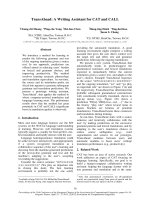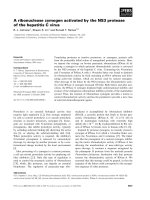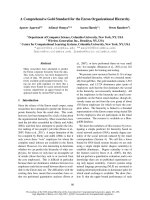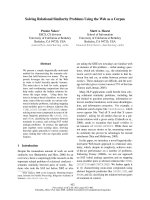Báo cáo khoa học: " A Cooperative Question-Answering System on the WEB" pdf
Bạn đang xem bản rút gọn của tài liệu. Xem và tải ngay bản đầy đủ của tài liệu tại đây (265.28 KB, 4 trang )
WEB COOP: A Cooperative Question-Answering System on the WEB
Farah Benamara
Patrick Saint Dizier
IRIT
IRIT
Toulouse III University
Toulouse III University
Abstract
The main aim of this project is to ex-
plore, develop and evaluate the contri-
bution of language technologies to the
development of
WEBCOOP,
a system
that provides intelligent Cooperative re-
sponses to Web queries. Such a sys-
tem requires the integration of knowl-
edge representation and the use of ad-
vanced reasoning procedures.
1 Introduction
The main aim of this project is to explore, develop
and evaluate the contribution of language tech-
nologies to the development of
WEBCOOP,
a sys-
tem that provides intelligent cooperative responses
to Web queries. Besides a heavy use of language
(processing queries, generating responses, extract-
ing knowledge from web pages), such a system
requires the integration of knowledge represen-
tation and the use of advanced reasoning proce-
dures. Moreover, the complexity of reasoning pro-
cedures must be kept reasonable in order to opti-
mise tractability, efficiency, and re-usability.
In a first stage, the project is developed on a
relatively limited domain that includes a number
of aspects of tourism (accommodation and trans-
portation, which have very different characteris-
tics on the web). In a second stage, we want to
evaluate the re-usability of our techniques to other
domains analysing where are the difficulties, what
are the costs, what is domain specific and what can
be shared.
A number of cooperative systems were de-
signed for databases in the past such as
COBASE
(Minock and Chu, 96) and
CARMIN
(Chakravarthy et al, 90). Most of the efforts
were concentrated on fundamental reasoning pro-
cedures, while very little attention was paid to
question analysis and to NL response generation.
Our challenge is to integrate reasoning procedures
with real-life data extracted from web pages and to
produce web style cooperative NL responses of a
reasonable quality that reflect the accuracy of the
reasoning procedures. A major feature is the in-
tegration of a real cooperative
know-how
compo-
nent that goes beyond the mere recognition of a
user misconception.
In the following sections, we briefly present the
main aspects of our system focussing on question
classification and knowledge representation. Co-
operative response elaboration and response gen-
eration are presented in (Benamara and Saint-
Dizier, 03).
2 What is a Cooperative Response ?
Cooperative answering systems are typically able
to provide general, descriptive answers along with
explanations about their answers. (Grice, 75)
maxims of conversation namely the
quality, quan-
tity, relation and
style
maxims are frequently used
as a basis for designing cooperative answering sys-
tems. To address these behaviours, specific coop-
erative techniques have been developed to iden-
tify and to explain false presuppositions or var-
ious types of misunderstandings found in ques-
tions. Relaxation of constraints in the question
63
occur when the system cannot find any response.
Finally, intentional responses may be provided in-
stead of a large set of extensional answers. An
overview of these aspects is given in (Gaasterland
et al, 94).
3 Cooperative Responses in WEBCOOP
In WEBCOOP, responses provided to users are
built in web style, by integrating natural language
generation (NLG) techniques with hypertext links
to produce "dynamic" responses. Responses are
structured in two parts. The first part contains ex-
planation elements which report user misconcep-
tions in relation with the domain knowledge. The
second part is the most important and the most
original. It reflects the
'know-how'
of the cooper-
ative system, going beyond the cooperative state-
ments given in part one. It is based on several
components: dedicated cooperative rules possibly
using knowledge extracted from web pages, re-
laxation strategies and the domain ontology. The
know-how
component also allows for the dynamic
determination of those text fragments to be defined
as hypertext links, from which the user can get
more information.
Let us consider a simple example. Suppose
one wishes to rent a country cottage in Midi
Pyrenees region by the seashore. Part 1 reports
a misconception. This entails the production of
the following message, generated from a logical
formula:
Midi Pyrenees region is not by the seashore.
In part 2, the
know-how
of the cooperative system
generates the possible flexible solutions below.
Dynamically created links are underlined
we propose you country cottages in
-
another region in France by the seashore
-
Midi Pyrenees region.
The formal aspects of the content determina-
tion and the dynamic generation of cooperative
responses are presented in (Benamara and Saint
Dizier, 03). In the next sections, we first character-
ize the typology of natural language questions that
WEBCOOP takes in and then specify the knowl-
edge extraction procedures from web pages.
4 Question classification and processing
In our system, we offer two modes for querying
a web page: either via keywords, which are then
interpreted as a simplified NL query, or in nat-
ural language. One of our first tasks is then to
elaborate a generic classification of the different
types of questions. Our taxonomy is inspired from
(Lehnert, 78) (QUALM system) and (Graesser and
Gordon, 91). It is therefore quite different from
taxonomies dedicated to open domain question
answering, for example within the TREC-8 and
the TREC-9 programs (Hovy et al, 00) which are
mainly based on question templates.
Our taxonomy has been constructed and evalu-
ated using a corpus elaborated from the Frequently
Asked Questions (FAQ) section of a number of
web services, among which services dedicated to
tourism. This corpus also defines a small but rep-
resentative subset of question types that character-
ize the different forms of cooperative responses we
are aiming at in WEBCOOP. W.r.t. to this corpus,
questions are classified according to their expected
responses:
-
atomic or enumerative
responses : boolean
(yes, no), enumeration of entities, quantity (num-
ber, time, etc.) or quality expressed by evaluative
adjectives. Do I need a visa to go from France to
Spain?,
induces a boolean response, and
What are
the rates of the Royal Hotel in Paris ?
induces a
response of type quantity.
-
narrative
responses, based on the following
conceptual categories : procedure, definition, de-
scription, cause, goal, evaluation and comparison.
Examples :
I want some information about Paris
underground
induces a response of type descrip-
tion, and
What is the difference between a country
cottage and a chalet?,
induces a comparison.
In an orthogonal way to the above fundamen-
tal typology, additional phenomena have been ob-
served such as:
-
questions including fuzzy terms (essentially
evaluative adjectives like
cheap
or
close to),
as
in:
a cheap country cottage close to the seaside
in COte d'Azur.
-
incomplete questions where essential elements
are missing, such as
What are the flights to
Toulouse ?
or, questions for which only portions
64
can be processed.
- questions based on a series of examples, such
as
I am looking for country cottages in the moun-
tain similar to ME Dupond cottage.
Since the WEBCOOP project is in an early
stage of development, we mainly focus on coop-
erativity for atomic or enumerative responses pos-
sibly including fuzzy expressions. This allows for
the evaluation of the expressivity of our formalism
(see section 5) as well as for the complexity of the
reasoning procedures and the NLG needs.
We have designed a bottom-up parser that pro-
duces a conceptual representation of questions.
Our strategy is to keep track of the terms used in
the question as much as possible in order to re-use
them in the response. For example, the question
Give me the Royal Hotel rates in Paris?
has the
following semantic representation
(Quantity, X : listof (rates), hotel(royal)
A
in(placc, royal, paris)
A
rates(royal, X) ).
5 Knowledge Representation
5.1 General principles
Our approach requires two, very classical, levels
of knowledge representation (Benamara 02): gen-
eral purpose knowledge, specified by hand, and
domain knowledge, acquired via knowledge ex-
traction procedures from web pages. A uniform
logical representation is used, based on a simpli-
fied version of the Lexical Conceptual Structure
(LCS), (Jackendoff, 90). The use of the LCS lan-
guage and the power of its primitive systems, al-
lows us to have relatively generic representations,
well-adapted for reasoning procedures.
The general purpose knowledge base describes
knowledge about the tourism domain. It contains
a domain ontology, a number of basic information
(e.g. country names, airlines), rules and integrity
constraints. It is not very big and can therefore be
reliably specified by hand (e.g. about 60 rules and
50 integrity constraints for accommodation). It is
clear, however, that to extend the knowledge base
to other domains, semi-automatic procedures are
necessary. We are currently exploring linguistic-
based methods to extract knowledge that expresses
causes, consequences and conditionals of various
forms.
Most of the knowledge is extracted from web
pages dedicated to tourism. We developed in the
past 3 years (under the
PRETI
project at
IRIT
1
)
a method and an algorithm that extracts knowl-
edge from web pages based on the domain ontol-
ogy. The basic principle is that each major node
of the ontology is associated with a dedicated lo-
cal grammar that recognizes, in the textual part
of a web page, information relevant to the con-
cept associated with that node. The parser dynam-
ically constructs a semantic representation under
the form of a frame with attribute-value pairs. Val-
ues can be atomic or fragments of LCS. A detailed
analysis of our corpus shows the prominent role
played by prepositions to describe e.g. localisa-
tion, instrument or purpose. Therefore, a great at-
tention is devoted to the extraction of predicative
forms.
As a result, knowledge extracted from a web
page is the concatenation of frame fragments cor-
responding to the nodes activated in the ontol-
ogy. Each frame fragment is linked to its origi-
nal web textual fragment. We also keep track of
the web page structure, since this is often useful
for response construction (to have access to com-
ments, lists of items or procedures, etc.). We then
have a database of web pages indexed by means
of frames. For our experiments, we work with a
database established once for all, but we foresee to
have it updated regularly, since web pages change
frequently.
5.2 An Example
Let us now consider an example that precisely de-
scribes the principles of our approach. We con-
sider an ontological description of the application
domain where nodes are concepts, decorated by
means of attributes which describe concept prop-
erties or any other relevant information. Since de-
scriptions are hierarchically organized, properties
are inherited, if there is no conflict. Local gram-
mars are associated with those properties. They
may be shared by several sister nodes, but in gen-
eral there are some differences. For example, the
expression of rates for a camping site is quite dif-
ferent from the expression of rates for a hotel or a
1
/>65
Acc mato dation Roc envt]
Tourist acc ■ :non [openitg dates]
Camping
hotel
[fares,services,
[fares, capaciLy]
ith
of lots]
bungalow. The figure above describes the accom-
modation ontology.
Grammars associated with properties are de-
signed (1) to extract the information judged rele-
vant for the property at stake and (2) to contribute
to the construction of the semantic representation.
In our experiment, grammars are written by hand,
from corpus samples. We have adopted the discon-
tinuous grammars formalism (Saint-Dizier, 88), a
DCG-type grammar which includes gaps which
are variables in the rule that stand for a finite
set of words to skip till a certain word or condi-
tion is met. These rules run in a bottom-up fash-
ion, allowing for the recognition of text fragments
distributed throughout a whole paragraph or web
page. A careful organization of rules make effi-
ciency quite acceptable. In our application, 20 dif-
ferent local grammars have been developed, with
a total of 65 extraction grammar rules.
For example, a grammar rule that deals with the
environment has the following form:
envt ( [at (place, X, Y) ] ) > prep (fixed-loc)
gap, lex (Y, noun, Sem_Type)
{ subsume (phys-loc, Sem_Type) } .
prep(fixed-loc) is any preposition that describes
a fixed localization (at, on, near, etc.). The gap
allows the parser to skip any irrelevant string till a
word denoting a physical location is found.
A web page is therefore 'indexed' using a set
of predicative forms. The knowledge extractor
car either extract all the information it can reli-
ably found or it can just extract information related
to pre-selected properties (something like views).
The result is a set of predicative forms (or possi-
bly just words when there is no predicate). Pred-
icative forms are marked by means of XML tags
which also appear in the original text in order to
keep track of the information source.
6 Conclusion
Implementation of this project is about half-way.
Evaluation is crucial on two dimensions : the qual-
ity of the services offered to a user and the re-
usability for other domains namely : where are the
difficulties, what are the costs, what is domain spe-
cific and what can be shared.
References
Benamara F and Saint Dizier P. 2003.
Dynamic Gen-
eration of Cooperative Natural Language Responses
in WEBCOOP.
Ninth European workshop on Natu-
ral Language Generation. EACL, Budapest, Hungry.
Benamara F. 2002. A
Semantic Representation For-
malism for Cooperative Question Answering Sys-
tems.
Proceeding of Knowledge Base Computer
Systems (KBCS), Mumbai, India, dec.
Chakravarthy U, Grant J, and Minker J. 1990.
Logic-
Based Approach to Semantic Query Optimisation,
ACM Transactions on Database Systems, 15(2):162-
207, 1990.
Gaasterland T, Godfrey P, Minker J. 1994.
An
Overview of Cooperative Answering.
Papers in
Non-standard Queries and Non-standard Answers,
in series Studies in Logic and Computation, Claren-
don Press, Oxford.
Graesser A, Gordon S. 1991.
Question-Ansvvering
and the Organization of the World Knowledge,
In
W. Kessen, A. Ortony, and F. Craik (Eds.), Mem-
ories, thoughts, and emotions: Essays in honor of
George Mandler. Hillsdale, NJ: Erlbaum.
Grice H. 1990.
Logic and Conversation,
In Cole and
Morgan editors, Syntax and Semantic, Academic
Press.
Hovy E, Gerber L, Hermjakob U, Junk M and
Lin C. 2000.
Question Answering in Webclopedia,
in Proceedings of the TREC-9 Conference, NIST.
Gaithersburg, MD.
Jackendoff R. 1990.
Semantic Structures,
MIT Press,
Cambridge M.A.
Lehnert W. 1978.
The Process of Question Answering:
a Computer Simulation of Cognition,
Lawrence Erl-
baum.
Minock M, Chu W. 1996.
Explanation for Coopera-
tive Information Systems, International Symposium
on Methodologies for Intelligent Systems, 264-273.
Saint-Dizier P. 1988.
Contextual Discontinuous
Grammars,
in Natural Language Understanding and
Logic Programming II, V. Dahl and P. Saint-Dizier
(eds.), North Holland.
Vares]
66









